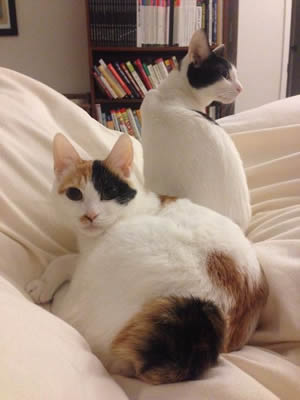Breed Standard
Head: Although the head appears long and chiseled, it forms almost a perfect equilateral triangle with gentle curving lines, high cheekbones, and a noticeable whisker break. Nose is long and well-defined by two parallel lines from tip to brown, with a gentle dip at, or just below, eye level. Allowance is made for jowls in the male. Ears are large and upright, set at right angles to the head, rather than flaring outward, and tilted slightly forward.
Eyes: Large, oval and expressive, set into the head with a pronounced slant. All eye colors are acceptable, with green or gold being the norm, but blue and odd-eyes are popular, as well.
Body: Torso is long, lean and elegant, medium in size, and exhibits well developed muscular strength without coarseness.
Legs: Long, slender and high, but not dainty. Hind legs noticeably longer than forelegs, but deeply angulated to bend when the cat stands so the torso remains nearly level rather than rising toward the rear.
Tail: The tail, often referred to as a “pompom”, is as unique to each individual cat as a fingerprint is to a human - no two are alike. Tail must be clearly visible and may be arranged in any combination of curves, kinks or angles, extending no further than 3 inches from the body. Boning may be flexible or rigid.
Coat: (Shorthair) Medium length, soft, silky, without a noticeable undercoat. (Longhair) Medium-long to long, soft and silky, no noticeable undercoat. Frontal ruff, ear and toe tufts desirable.
Color: Although coat colors vary, the majority are predominantly white, with patches of color. The calico is especially popular, and is known as mi-ke, a Japanese term meaning “three fur” - red/black/white.
Fault: Tail bone absent or extending too far beyond body. Tail lacking in pompom or fluffy appearance. Short round head or cobby build.
History
A natural breed, as opposed to man-made, this is one of the oldest breeds, their historical presence having been traced to the 7th century in Japan. Today’s museums display ancient wood-cuts, silk-screened prints, tapestries and statuary of cats with short, pompom tails. The 17th-century Gotojuki Temple in Tokyo is decorated with a frieze of bobtailed cats sitting with their right forepaws raised in greeting, a gesture that Japanese folklore claims will bring good luck. Small replica statues, called maneki neko (beckoning cat) can be found throughout Japan and in Asian shops and restaurants throughout the world. These ceramics are believed to bring fortune and health to their owners.
Behavior
Bobtails are wonderful, affectionate and healthy companions. Extremely intelligent, outgoing and friendly, most will play "fetch", and almost all come when called. JBTs have a great sense of adventure, are friendly with dogs and other breeds of cats, and are especially patient with children.
Health
Just like any animal, there can be a number of different health problems that could be related to the genetics. This being said, the Japanese Bobtails are generally healthy cats. The recessive gene paired with the shortened tails is not associated with any spinal or bone abnormalities.






